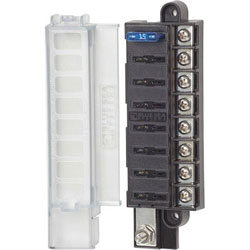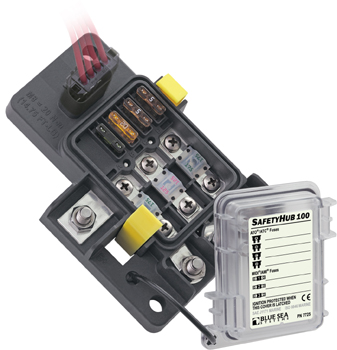The Ultimate Guide To Blue Sea Fuse Block
Wiki Article
Blue Sea Fuse Block for Beginners
Table of ContentsFascination About Blue Sea Fuse Block6 Simple Techniques For Blue Sea Fuse BlockSome Known Details About Blue Sea Fuse Block Blue Sea Fuse Block for Beginners7 Easy Facts About Blue Sea Fuse Block ExplainedBlue Sea Fuse Block Fundamentals Explained
Fuses are bolted in position in between the bus bar and also the 2nd collection of electrically separated screws. With this installment you can affix the watercraft's various high-current circuits, such as a windlass, bow thruster, high-output generator, the DC panel, and so on, to the isolated bolts. The various fuses are sized according to the current-carrying capability of the conductors bolted to them.Some circuits will certainly still require to bypass the isolation switch to ensure that they may be left on when the rest of the boat is shut down. blue sea fuse block. These circuits usually include a bilge pump and also any kind of billing gadgets (including solar panels, perhaps a wind generator, as well as the inverter if it likewise doubles as a battery charger).
This belongs to the circuit diagram we developed for the complex instance boat in our Boat Electrics training course. The tools linked to the fuse block in the upper right are all bypassing the seclusion button S1. If you enroll in Boat Electrics 101, you will certainly find out exactly how to check out such a representation and additionally just how to make one for your very own boat.
Excitement About Blue Sea Fuse Block

The objective is to give defense at the resource of power for each circuit. With DC circuits, the OCP is always put in the silver lining of DC circuits. (In addition to anything else, an unbroken link to DC adverse must be maintained whatsoever times to protect against stray-current rust.) Keep in mind that some European boatbuilders mount integrates and battery switches in the DC negative side and on the positive side, but this is not suggested other than in some separated (drifting) ground DC systems.
This factor may be at the battery, the battery button, the circulation panel, a subsidiary panel, some distribution bus bar, or other attaching factor. If the conductors in the brand-new circuit are no smaller than the conductor that feeds the brand-new circuit's factor of connection, then the OCP for the feeder conductor will adequately safeguard the new circuit - blue sea fuse block.
The Definitive Guide for Blue Sea Fuse Block
But if the brand-new circuit is not sufficiently offered by overcurrent gadgets already in position, added security is needed at its point of connection, i. e., at its resource of power. Positioning of fuses in the positive conductor. Keep in mind exactly how a smaller fuse is made use of each time a smaller sized conductor is connected, Sometimes area limits exactly how close an OCP tool can be placed to the source of power.The common answer, from the ABYC, is within 7" (17. The ABYC allows the following, which have been tightened up in current years: A conductor connected directly to a battery that is also "included throughout its entire distance in a sheath or enclosure such as a channel, joint box, control box or encased panel" need to have its overcurrent security "as close as possible to the battery, yet not to go beyond 72 inches (1.
Gone is the covering 72" allocation that made use of to be there. A conductor connected to a source of power aside from the battery (e. g., the battery switch, the distribution panel, or a few other factor in the DC circuits) that is in a similar way had in a sheath, and so on, have to have its overcurrent defense "as close as achievable to the point of link to the source of power, however not to exceed 40 look these up inches (1.
The Buzz on Blue Sea Fuse Block
Offered that alternators themselves are a resource of power, it has actually been open to question whether these added generators required OCP at the generator itself."Cranking-motor circuits are not required to have overcurrent security.In the marine area, where cranking circuits may be long, this method could create a hazard. If a car ignites, the owners can pull over as well as leap out. If a boat catches fire, it is not so straightforward. It makes no sense to have any kind of unguarded circuits on a watercraft.
In winter, the inrush current on a 12V starter motor may be as high as 1,500 amps; the cranking current might be as high as 200 amps. Commonly, cranking conductors are undersized also for the cranking current, let alone the inrush current. This scenario does not posture a safety issue per se, due to the fact that these currents are received for just a few seconds, so the conductors do not read review have time to get hot sufficient to develop a fire threat.
The Best Guide To Blue Sea Fuse Block
We made the course with outright novices in mind. As the electrical load on watercrafts boosts, so as well does the complexity of electric circuits as well as the potential for short circuits and also electric fires.
In the aquatic area, where cranking circuits might be long, this practice might produce a danger. It makes no feeling to have any kind of unprotected circuits on a watercraft.
5 Easy Facts About Blue Sea Fuse Block Described

If you intend to discover just how to wire a boat, step-by-step in 56 video clip lessons, take a look at our Watercraft Electrics 101 course. We made the course with outright beginners in mind. As the electric load on watercrafts increases, so also does the complexity useful reference of electric circuits and the possibility for short circuits and also electrical fires.
Report this wiki page